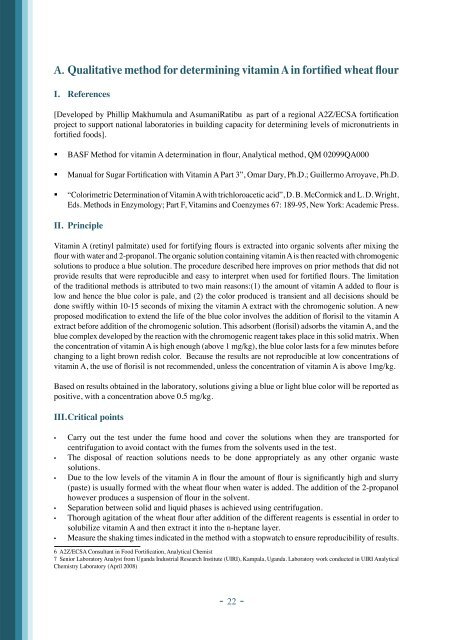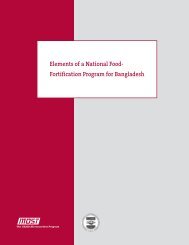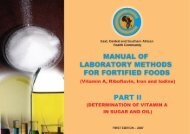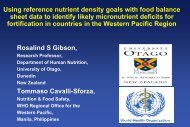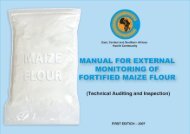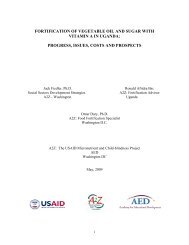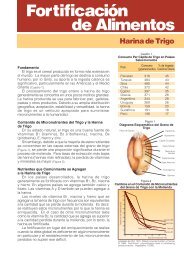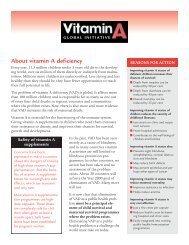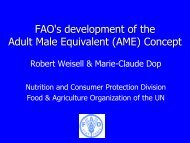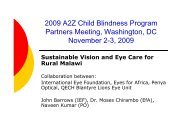manual of methods for determining micronutrients in fortified foods
manual of methods for determining micronutrients in fortified foods
manual of methods for determining micronutrients in fortified foods
Create successful ePaper yourself
Turn your PDF publications into a flip-book with our unique Google optimized e-Paper software.
A. Qualitative method <strong>for</strong> <strong>determ<strong>in</strong><strong>in</strong>g</strong> vitam<strong>in</strong> A <strong>in</strong> <strong>for</strong>tified wheat flour<br />
I. References<br />
[Developed by Phillip Makhumula and AsumaniRatibu as part <strong>of</strong> a regional A2Z/ECSA <strong>for</strong>tification<br />
project to support national laboratories <strong>in</strong> build<strong>in</strong>g capacity <strong>for</strong> <strong>determ<strong>in</strong><strong>in</strong>g</strong> levels <strong>of</strong> <strong>micronutrients</strong> <strong>in</strong><br />
<strong>for</strong>tified <strong>foods</strong>].<br />
• BASF Method <strong>for</strong> vitam<strong>in</strong> A determ<strong>in</strong>ation <strong>in</strong> flour, Analytical method, QM 02099QA000<br />
• Manual <strong>for</strong> Sugar Fortification with Vitam<strong>in</strong> A Part 3”, Omar Dary, Ph.D.; Guillermo Arroyave, Ph.D.<br />
• “Colorimetric Determ<strong>in</strong>ation <strong>of</strong> Vitam<strong>in</strong> A with trichloroacetic acid”, D. B. McCormick and L. D. Wright,<br />
Eds. Methods <strong>in</strong> Enzymology; Part F, Vitam<strong>in</strong>s and Coenzymes 67: 189-95, New York: Academic Press.<br />
II. Pr<strong>in</strong>ciple<br />
Vitam<strong>in</strong> A (ret<strong>in</strong>yl palmitate) used <strong>for</strong> <strong>for</strong>tify<strong>in</strong>g flours is extracted <strong>in</strong>to organic solvents after mix<strong>in</strong>g the<br />
flour with water and 2-propanol. The organic solution conta<strong>in</strong><strong>in</strong>g vitam<strong>in</strong> A is then reacted with chromogenic<br />
solutions to produce a blue solution. The procedure described here improves on prior <strong>methods</strong> that did not<br />
provide results that were reproducible and easy to <strong>in</strong>terpret when used <strong>for</strong> <strong>for</strong>tified flours. The limitation<br />
<strong>of</strong> the traditional <strong>methods</strong> is attributed to two ma<strong>in</strong> reasons:(1) the amount <strong>of</strong> vitam<strong>in</strong> A added to flour is<br />
low and hence the blue color is pale, and (2) the color produced is transient and all decisions should be<br />
done swiftly with<strong>in</strong> 10-15 seconds <strong>of</strong> mix<strong>in</strong>g the vitam<strong>in</strong> A extract with the chromogenic solution. A new<br />
proposed modification to extend the life <strong>of</strong> the blue color <strong>in</strong>volves the addition <strong>of</strong> florisil to the vitam<strong>in</strong> A<br />
extract be<strong>for</strong>e addition <strong>of</strong> the chromogenic solution. This adsorbent (florisil) adsorbs the vitam<strong>in</strong> A, and the<br />
blue complex developed by the reaction with the chromogenic reagent takes place <strong>in</strong> this solid matrix. When<br />
the concentration <strong>of</strong> vitam<strong>in</strong> A is high enough (above 1 mg/kg), the blue color lasts <strong>for</strong> a few m<strong>in</strong>utes be<strong>for</strong>e<br />
chang<strong>in</strong>g to a light brown redish color. Because the results are not reproducible at low concentrations <strong>of</strong><br />
vitam<strong>in</strong> A, the use <strong>of</strong> florisil is not recommended, unless the concentration <strong>of</strong> vitam<strong>in</strong> A is above 1mg/kg.<br />
Based on results obta<strong>in</strong>ed <strong>in</strong> the laboratory, solutions giv<strong>in</strong>g a blue or light blue color will be reported as<br />
positive, with a concentration above 0.5 mg/kg.<br />
III. Critical po<strong>in</strong>ts<br />
• Carry out the test under the fume hood and cover the solutions when they are transported <strong>for</strong><br />
centrifugation to avoid contact with the fumes from the solvents used <strong>in</strong> the test.<br />
• The disposal <strong>of</strong> reaction solutions needs to be done appropriately as any other organic waste<br />
solutions.<br />
• Due to the low levels <strong>of</strong> the vitam<strong>in</strong> A <strong>in</strong> flour the amount <strong>of</strong> flour is significantly high and slurry<br />
(paste) is usually <strong>for</strong>med with the wheat flour when water is added. The addition <strong>of</strong> the 2-propanol<br />
however produces a suspension <strong>of</strong> flour <strong>in</strong> the solvent.<br />
• Separation between solid and liquid phases is achieved us<strong>in</strong>g centrifugation.<br />
• Thorough agitation <strong>of</strong> the wheat flour after addition <strong>of</strong> the different reagents is essential <strong>in</strong> order to<br />
solubilize vitam<strong>in</strong> A and then extract it <strong>in</strong>to the n-heptane layer.<br />
• Measure the shak<strong>in</strong>g times <strong>in</strong>dicated <strong>in</strong> the method with a stopwatch to ensure reproducibility <strong>of</strong> results.<br />
6 A2Z/ECSA Consultant <strong>in</strong> Food Fortification, Analytical Chemist<br />
7 Senior Laboratory Analyst from Uganda Industrial Research Institute (UIRI), Kampala, Uganda. Laboratory work conducted <strong>in</strong> UIRI Analytical<br />
Chemistry Laboratory (April 2008)<br />
- 22 -


